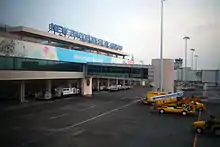Bacolod–Silay Airport
Bacolod–Silay Airport (Hiligaynon: Hulugpaan sang Bacolod–Silay; Filipino: Paliparan ng Bacolod–Silay; IATA: BCD, ICAO: RPVB) is the main airport serving the general area of Metro Bacolod, in the Western Visayas region of the Philippines.[2][3]
Bacolod–Silay Airport Hulugpaan sang Bacolod–Silay Paliparan ng Bacolod–Silay | |||||||||||
|---|---|---|---|---|---|---|---|---|---|---|---|
 Airport exterior | |||||||||||
| Summary | |||||||||||
| Airport type | Public | ||||||||||
| Operator | Civil Aviation Authority of the Philippines | ||||||||||
| Serves | Metro Bacolod, Western Visayas, and some parts of Central Visayas | ||||||||||
| Location | Bagtic, Silay, Negros Occidental | ||||||||||
| Opened | 17 January 2008 | ||||||||||
| Elevation AMSL | 86 ft / 26 m | ||||||||||
| Coordinates | 10°46′35″N 123°00′55″E | ||||||||||
| Website | www | ||||||||||
| Map | |||||||||||
.svg.png.webp) BCD/RPVB Location in the Philippines | |||||||||||
| Runways | |||||||||||
| |||||||||||
| Statistics (2018) | |||||||||||
| |||||||||||
Source: eFOI[1] | |||||||||||
The airport is located 15 kilometers northeast of Bacolod on a 181-hectare site in Barangay Bagtic, Silay, Negros Occidental.[4] The facility inherited its IATA and ICAO airport codes from Bacolod City Domestic Airport, which it replaced in 2008. Capable of handling international air traffic, the airport is the busier of the two major airports serving Negros Island, the other being Dumaguete Airport in Sibulan, Negros Oriental.
The Bacolod–Silay Airport is designated as a Principal-Class 1 Domestic Airport by the Civil Aviation Authority of the Philippines, a body of the Department of Transportation that is responsible for the operations of not only this airport but also of all other public airports in the Philippines except the major international airports.[3]
History
The site of Bacolod–Silay Airport was one of the main airfields for the Imperial Japanese Army Air Service (IJAAS) bombers and fighters in Negros. It was captured by American forces in 1944 and 1945. After the war, parts of the airfield became a sugarcane plantation.

Planning for a new airport for Bacolod commenced in 1997, when the Japan International Cooperation Agency initiated a study indicating the need for expansion at four Philippine airports: namely Bacolod City Domestic Airport, Mandurriao Airport in Iloilo City, Legazpi Airport in Legazpi and Daniel Z. Romualdez Airport in Tacloban.[5]
In February 1999, another JICA study was commissioned, this time on the detailed plan of the new airport.[5] The study was completed by March 2000 and was funded by a 430 million-yen grant. Immediately after the completion of the study, JICA hired Pacific Consultants International as advisers to the project.[5]
The project was opened for bidding on 25 August 2003, with the winning bid going to the Takenaka–Itochu Joint Venture (TIJV).[5] Physical construction on the new 4.3 billion-peso airport, funded in part by an 8.2 billion yen loan, commenced in August 2004.[4] A 900-day deadline was imposed for the airport to be completed, which broadly corresponded to January 2007.[5] During construction, remains of the Japanese airfield and some war aircraft wrecks were dug.
On 13 July 2007, President Gloria Macapagal-Arroyo attended the facility's inauguration.[6] The airport was considered complete by 16 July 2007, but there was "considerable debate" over whether the airport should be opened for regular commercial traffic due to the 500-meter runway extension, necessary for accommodating larger aircraft, not having been built by that time.[7]

The first aircraft ever to land at the airport was a small fourteen-seater turboprop owned by Vincent Aviation. The Reims-Cessna F406 with aircraft registration number ZK-VA, piloted by Steve Gray of New Zealand landed at the airport at 9:55 a.m., 26 September 2007.[8]
The airport commenced regular commercial operations and was officially opened on 18 January 2008.[8] The first commercial flight to arrive was Cebu Pacific's Flight 5J 473 from Manila, an Airbus A319-100 piloted by Silay native Captain Allan Garces which landed at 5:22 a.m. PST on the day of opening.[8] The first international flight to arrive at the airport was a chartered plane from Almaty, Kazakhstan which landed at 10:58 a.m. on 2 January 2009 carrying eight passengers and eight crew members.[9][10]
Zest Air chartered international flights to and from Incheon using the Airbus A320 from 7 January to 22 February 2012, and also used to serve the route seasonally for South Korean golfers.[11] This seasonal route was also operated by Philippine Airlines utilizing the Airbus A321, offering flights to non-golfers and the local flying public.
By late 2014, the airport has been equipped with Customs, Immigration and Quarantine booths in preparation for the increase in international arrivals.[12] Since October 2015 the Bureau of Immigration has also indicated readiness to deploy personnel at the airport should regularly scheduled international flights commence, but as of 2017, there are no regularly scheduled international flights operating to and from the airport.[13]
Structure
Runway
The Bacolod–Silay Airport has one primary runway, which is 45 meters (148 ft) wide and 2,002 meters (6,568 ft) long. The runway runs in a direction of 03°/21°, and can currently handle aircraft as large as the Airbus A330.[14] Provisions for a 500-meter (1,600 ft) expansion of the present runway in order to accommodate even larger aircraft were confirmed on 23 May 2009, when it was reported that the budget for the construction of the 500-meter extension of the runway has been approved by the Philippine government and bidding and construction was slated to start in the 3rd or 4th quarter of 2009, but it has not been expanded yet.[15]
The airport is equipped with an instrument landing system (ILS), making it capable of handling night and low-visibility landings.

Passenger terminal

The entire airport complex is designed to handle an excess of one million passengers and 16,715 tons of cargo annually and consists of 21 buildings with a total floor space of 10,075 square meters (108,450 sq ft).[5]
The largest building in the complex is the 6,187-square-meter (66,600 sq ft) main passenger terminal with three levels.[5] The ground floor holds the check-in counters, the public concourse, the arrival area and the information counter. The second floor has the three pre-departure areas with their VIP and CIP lounges; these pre-departure areas lead out to three (3) jet bridges at an apron that can handle up to five aircraft simultaneously. Philippine Airlines also operates a Mabuhay Lounge for the use of its business class passengers on the second floor.[16] Also on the second floor are Merci Pasalubong Shop and Bong-Bong's Pasalubong Shop, occupying the spot of the former Civil Aviation Authority of the Philippines office since it transferred to the Administration Building. On the third floor is the viewing deck with a concession area and rooms for maintenance and airport machinery.[14]
The state-of-the-art main passenger terminal is equipped with a flight information display system, mechanized baggage handling systems for both inbound and outbound baggage, numerous security x-ray machines, and elevators, and escalators.[14] Outside the main terminal is a parking lot good for 350 cars.[5]
Statistics
Data from Civil Aviation Authority of the Philippines[17]
Passenger movements
|
Aircraft movements
|
Cargo movements
|
Ground transportation
Airport transportation is accessible to passengers travelling in or out of the airport from Bacolod. There are multiple Public Utility Vehicles (PUVs) that offer shuttle services. There are also tricycles outside the airport that provide transportation to nearby destinations in Silay. The new access road connecting the airport and Bacolod is completed and is now accessible to vehicles. It connects to Barangay Bata in Bacolod.
Airlines and destinations
As of June 8, 2020, some flights have resumed, with particular schedules of operations mandated by the City Mayor. However, due to cancellation of flights following the COVID-19 pandemic, this list is no longer current and destinations are subject to change without prior notice.[18]
Passenger
| Airlines | Destinations |
|---|---|
| Cebu Pacific | Clark, Davao, Manila |
| Cebu Pacific operated by Cebgo | Cebu |
| Philippine Airlines operated by PAL Express | Cebu, Clark, Manila |
| Philippines AirAsia | Manila |
References
- Civil Aviation Authority of the Philippines - Aerodrome Development & Management Service (15 April 2018). "Passenger Statistics Philippines". Republic of the Philippines - Freedom of Information Portal. Retrieved 27 April 2019.
- "Bacolod Airport Operations, Maintenance & Development Project". Public-Private Partnership Center, Republic of the Philippines. 21 April 2017. Retrieved 2 May 2017.
- "CAAP Airport Directory". Civil Aviation Authority of the Philippines. August 2016. Archived from the original on 2017-05-14. Retrieved 2 May 2017.
- Hibionada, Florence F. (4 December 2007). "Turn over of P4.3M Bacolod–Silay airport to DOTC today". The News Today. Retrieved 2 May 2017.
- Bacolod Airport (BCD), Negros Island, Philippines, Airport Technology, retrieved 4 August 2007
- Philippine News Agency (5 July 2007). "PGMA to inaugurate new Bacolod-Silay Airport on July 13". The News Today. Retrieved 2 May 2017.
- Gomez, Carla (14 July 2007). "GMA: Silay airport ready, debate delaying opening". The Visayan Daily Star. Retrieved 2 May 2017.
- "Silay City – Welcome to the Front Page". Silay City Official Government Website. 18 January 2008. Archived from the original on 15 September 2008. Retrieved 2 May 2017.
- Espina, Rolly (6 January 2009). "New Year's flight from Kazakhstan in Silay Airport". The Philippine Star. Retrieved 10 January 2009.
- "International Plane that landed in Silay Airport". Bacolod Beat. 3 January 2009. Archived from the original on 2 April 2016. Retrieved 2 May 2017.CS1 maint: bot: original URL status unknown (link)
- Gomez, Carla (7 December 2011). "NEWSBRIEFS". Philippine Daily Inquirer. Retrieved 3 January 2012.
- Philippine News Agency (27 October 2014). "Bacolod-Silay Airport prepares for international flights". Business Mirror. Retrieved 27 May 2014.
- Ellera, Teresa D. (1 October 2015). "BI set to deploy personnel, equipment at Silay Airport". SunStar Bacolod. Retrieved 2 May 2017.
- "New Bacolod–Silay airport opened". Philippine Daily Inquirer. 18 January 2008. Archived from the original on 20 January 2008. Retrieved 2 May 2017.
- Gomez, Carla (23 May 2009). "P300M for Bacolod runway approved". Philippine Daily Inquirer. Archived from the original on 27 May 2009. Retrieved 3 June 2009.
- "Domestic Lounge". www.philippineairlines.com. Retrieved 2021-02-05.
- Civil Aviation Authority of the Philippines (23 July 2018). "Yearly Passenger, Cargo and Aircraft Movements of all airports in the Philippines 1997–2017". Republic of the Philippines – Freedom of Information Portal. Retrieved 13 August 2018.
- "Corona Virus Disease 2019 (COVID-19)". www.philippineairlines.com. Retrieved 2020-08-02.